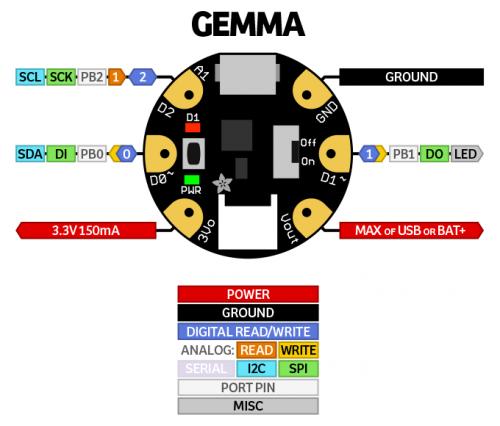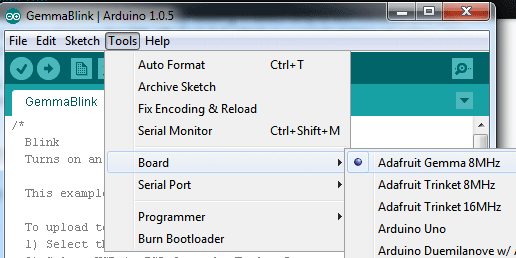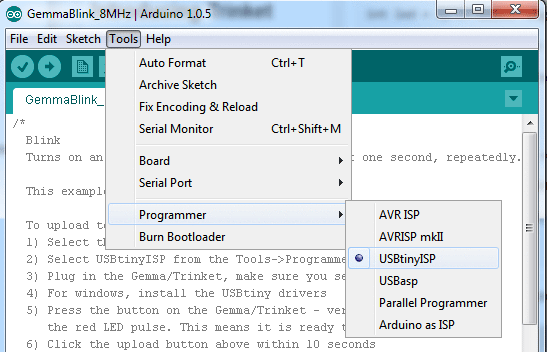Aj Ty v IT: Rozdiel medzi revíziami
Zo stránky SensorWiki
Bez shrnutí editace |
|||
| Riadok 114: | Riadok 114: | ||
</source> | </source> | ||
== NeoPixel RGB | == NeoPixel RGB == | ||
<source lang="C"> | |||
#include <Adafruit_NeoPixel.h> | |||
#define PIN 1 | |||
Adafruit_NeoPixel strip = Adafruit_NeoPixel(1, PIN, NEO_GRB + NEO_KHZ800); | |||
void setup() { | |||
strip.begin(); | |||
// strip.setPixelColor(n, red, green, blue, white); | |||
strip.setPixelColor(0, 0, 0, 127); | |||
strip.show(); // Initialize all pixels to 'off' | |||
delay(2000); | |||
} | |||
void loop() { | |||
strip.setBrightness(100); | |||
// Some example procedures showing how to display to the pixels: | |||
colorWipe(strip.Color(255, 0, 0), 50); // Red | |||
colorWipe(strip.Color(0, 255, 0), 50); // Green | |||
colorWipe(strip.Color(0, 0, 255), 50); // Blue | |||
//colorWipe(strip.Color(0, 0, 0, 255), 50); // White RGBW | |||
// Send a theater pixel chase in... | |||
// theaterChase(strip.Color(127, 127, 127), 50); // White | |||
// theaterChase(strip.Color(127, 0, 0), 50); // Red | |||
// theaterChase(strip.Color(0, 0, 127), 50); // Blue | |||
rainbow(20); | |||
// rainbowCycle(20); | |||
// theaterChaseRainbow(50); | |||
} | |||
// Fill the dots one after the other with a color | |||
void colorWipe(uint32_t c, uint8_t wait) { | |||
for(uint16_t i=0; i<strip.numPixels(); i++) { | |||
strip.setPixelColor(i, c); | |||
strip.show(); | |||
delay(wait); | |||
} | |||
} | |||
void rainbow(uint8_t wait) { | |||
uint16_t i, j; | |||
for(j=0; j<256; j++) { | |||
for(i=0; i<strip.numPixels(); i++) { | |||
strip.setPixelColor(i, Wheel((i+j) & 255)); | |||
} | |||
strip.show(); | |||
delay(wait); | |||
} | |||
} | |||
// Slightly different, this makes the rainbow equally distributed throughout | |||
void rainbowCycle(uint8_t wait) { | |||
uint16_t i, j; | |||
for(j=0; j<256*5; j++) { // 5 cycles of all colors on wheel | |||
for(i=0; i< strip.numPixels(); i++) { | |||
strip.setPixelColor(i, Wheel(((i * 256 / strip.numPixels()) + j) & 255)); | |||
} | |||
strip.show(); | |||
delay(wait); | |||
} | |||
} | |||
//Theatre-style crawling lights. | |||
void theaterChase(uint32_t c, uint8_t wait) { | |||
for (int j=0; j<10; j++) { //do 10 cycles of chasing | |||
for (int q=0; q < 3; q++) { | |||
for (uint16_t i=0; i < strip.numPixels(); i=i+3) { | |||
strip.setPixelColor(i+q, c); //turn every third pixel on | |||
} | |||
strip.show(); | |||
delay(wait); | |||
for (uint16_t i=0; i < strip.numPixels(); i=i+3) { | |||
strip.setPixelColor(i+q, 0); //turn every third pixel off | |||
} | |||
} | |||
} | |||
} | |||
//Theatre-style crawling lights with rainbow effect | |||
void theaterChaseRainbow(uint8_t wait) { | |||
for (int j=0; j < 256; j++) { // cycle all 256 colors in the wheel | |||
for (int q=0; q < 3; q++) { | |||
for (uint16_t i=0; i < strip.numPixels(); i=i+3) { | |||
strip.setPixelColor(i+q, Wheel( (i+j) % 255)); //turn every third pixel on | |||
} | |||
strip.show(); | |||
delay(wait); | |||
for (uint16_t i=0; i < strip.numPixels(); i=i+3) { | |||
strip.setPixelColor(i+q, 0); //turn every third pixel off | |||
} | |||
} | |||
} | |||
} | |||
// Input a value 0 to 255 to get a color value. | |||
// The colours are a transition r - g - b - back to r. | |||
uint32_t Wheel(byte WheelPos) { | |||
WheelPos = 255 - WheelPos; | |||
if(WheelPos < 85) { | |||
return strip.Color(255 - WheelPos * 3, 0, WheelPos * 3); | |||
} | |||
if(WheelPos < 170) { | |||
WheelPos -= 85; | |||
return strip.Color(0, WheelPos * 3, 255 - WheelPos * 3); | |||
} | |||
WheelPos -= 170; | |||
return strip.Color(WheelPos * 3, 255 - WheelPos * 3, 0); | |||
} | |||
</source> | |||
Priklady na neopixel | Priklady na neopixel | ||
Verzia z 14:11, 13. jún 2017

Svetielkujúci Workshop 7. a 14. 6. 2017
Úvod
Krok za krokom
1. Blink
2. Železničné priecestie
3. K.I.T.T. 2000
Druhá časť
Adafruit Gemma

V programovacom prostredí Arduino treba najprv nastaviť typ elektronickej dosky na Adafruit Gemma 8MHz v menu Tools->Board.

Potom ešte treba vybrať vhodný programovací protokol -
vyeberiete ho z menu Tools->Programmer->USBtinyISP

Vyskúšame postupne jednoduché programy
/* Blink 1 */
#define RED_LED 1
void setup() {
pinMode(RED_LED, OUTPUT);
}
void loop() {
digitalWrite(RED_LED, HIGH);
delay(200);
digitalWrite(RED_LED, LOW);
delay(200);
}
/* Blink 3 */
#define RED_LED 0
#define GREEN_LED 1
#define BLUE_LED 2
void setup() {
pinMode(RED_LED, OUTPUT);
pinMode(GREEN_LED, OUTPUT);
pinMode(BLUE_LED, OUTPUT);
}
void loop() {
digitalWrite(RED_LED, HIGH);
delay(200);
digitalWrite(RED_LED, LOW);
delay(200);
digitalWrite(GREEN_LED, HIGH);
delay(200);
digitalWrite(GREEN_LED, LOW);
delay(200);
digitalWrite(BLUE_LED, HIGH);
delay(200);
digitalWrite(BLUE_LED, LOW);
delay(200);
}
NeoPixel RGB
#include <Adafruit_NeoPixel.h>
#define PIN 1
Adafruit_NeoPixel strip = Adafruit_NeoPixel(1, PIN, NEO_GRB + NEO_KHZ800);
void setup() {
strip.begin();
// strip.setPixelColor(n, red, green, blue, white);
strip.setPixelColor(0, 0, 0, 127);
strip.show(); // Initialize all pixels to 'off'
delay(2000);
}
void loop() {
strip.setBrightness(100);
// Some example procedures showing how to display to the pixels:
colorWipe(strip.Color(255, 0, 0), 50); // Red
colorWipe(strip.Color(0, 255, 0), 50); // Green
colorWipe(strip.Color(0, 0, 255), 50); // Blue
//colorWipe(strip.Color(0, 0, 0, 255), 50); // White RGBW
// Send a theater pixel chase in...
// theaterChase(strip.Color(127, 127, 127), 50); // White
// theaterChase(strip.Color(127, 0, 0), 50); // Red
// theaterChase(strip.Color(0, 0, 127), 50); // Blue
rainbow(20);
// rainbowCycle(20);
// theaterChaseRainbow(50);
}
// Fill the dots one after the other with a color
void colorWipe(uint32_t c, uint8_t wait) {
for(uint16_t i=0; i<strip.numPixels(); i++) {
strip.setPixelColor(i, c);
strip.show();
delay(wait);
}
}
void rainbow(uint8_t wait) {
uint16_t i, j;
for(j=0; j<256; j++) {
for(i=0; i<strip.numPixels(); i++) {
strip.setPixelColor(i, Wheel((i+j) & 255));
}
strip.show();
delay(wait);
}
}
// Slightly different, this makes the rainbow equally distributed throughout
void rainbowCycle(uint8_t wait) {
uint16_t i, j;
for(j=0; j<256*5; j++) { // 5 cycles of all colors on wheel
for(i=0; i< strip.numPixels(); i++) {
strip.setPixelColor(i, Wheel(((i * 256 / strip.numPixels()) + j) & 255));
}
strip.show();
delay(wait);
}
}
//Theatre-style crawling lights.
void theaterChase(uint32_t c, uint8_t wait) {
for (int j=0; j<10; j++) { //do 10 cycles of chasing
for (int q=0; q < 3; q++) {
for (uint16_t i=0; i < strip.numPixels(); i=i+3) {
strip.setPixelColor(i+q, c); //turn every third pixel on
}
strip.show();
delay(wait);
for (uint16_t i=0; i < strip.numPixels(); i=i+3) {
strip.setPixelColor(i+q, 0); //turn every third pixel off
}
}
}
}
//Theatre-style crawling lights with rainbow effect
void theaterChaseRainbow(uint8_t wait) {
for (int j=0; j < 256; j++) { // cycle all 256 colors in the wheel
for (int q=0; q < 3; q++) {
for (uint16_t i=0; i < strip.numPixels(); i=i+3) {
strip.setPixelColor(i+q, Wheel( (i+j) % 255)); //turn every third pixel on
}
strip.show();
delay(wait);
for (uint16_t i=0; i < strip.numPixels(); i=i+3) {
strip.setPixelColor(i+q, 0); //turn every third pixel off
}
}
}
}
// Input a value 0 to 255 to get a color value.
// The colours are a transition r - g - b - back to r.
uint32_t Wheel(byte WheelPos) {
WheelPos = 255 - WheelPos;
if(WheelPos < 85) {
return strip.Color(255 - WheelPos * 3, 0, WheelPos * 3);
}
if(WheelPos < 170) {
WheelPos -= 85;
return strip.Color(0, WheelPos * 3, 255 - WheelPos * 3);
}
WheelPos -= 170;
return strip.Color(WheelPos * 3, 255 - WheelPos * 3, 0);
}
Priklady na neopixel
Technicke informacie
- Adafruit Gemma Windows Driver: https://learn.adafruit.com/introducing-gemma/windows-setup
- Adafruit Board Arduino Manager: https://adafruit.github.io/arduino-board-index/package_adafruit_index.json
- Neopixel Library: https://github.com/adafruit/Adafruit_NeoPixel
